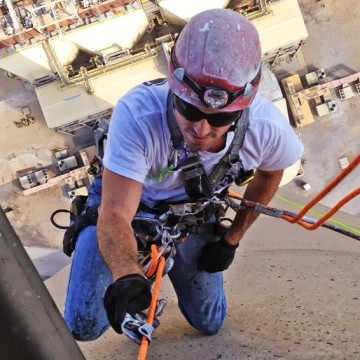Non-Destructive Structural Testing Eliminates the Guesswork
 Industrial chimneys are subject to multiple stresses and sources of wear and tear, including temperature excursions, chemical attack, wind loading and potentially, seismic events. Byproducts in the plant exhaust stream can wear out the interior of stacks and chimneys leading to rust, masonry deterioration, or thinning and de-lamination of fiberglass reinforced plastic liners or shells, causing leaks. While an industrial chimney or smokestack inspection is recommended every 6 to 24 months depending on usage, age, and environment, there are a number of nondestructive testing methods (NDT) that will be able to quickly and easily provide information on their integrity and condition.
Industrial chimneys are subject to multiple stresses and sources of wear and tear, including temperature excursions, chemical attack, wind loading and potentially, seismic events. Byproducts in the plant exhaust stream can wear out the interior of stacks and chimneys leading to rust, masonry deterioration, or thinning and de-lamination of fiberglass reinforced plastic liners or shells, causing leaks. While an industrial chimney or smokestack inspection is recommended every 6 to 24 months depending on usage, age, and environment, there are a number of nondestructive testing methods (NDT) that will be able to quickly and easily provide information on their integrity and condition.
NDT methods are designed to examine the structural integrity and condition of a smokestack or chimney in a manner that does not affect its usefulness or performance. These tests can provide a baseline and subsequent periodic measurements of structural characteristics such as the material’s surface hardness, density, and thickness. The results can support sound choices for future repair or replacement expenditures.
Here are some typical methods of NDT that can be used on concrete structures like industrial chimneys:
-
Visual Inspection- This is a precursor to NDT testing. A technician will perform a visual inspection first to determine the possible causes of damage to the structure and help identify which NDT method will be the most useful for finding out more information.
-
Ultrasonic Testing- These NDT tests are typically a method for determining the strength of a structure based on the thickness of the material, such as steel plate. Areas of significantly reduced steel thickness typically represent abnormal wear from chemical (corrosive) or mechanical (erosive) factors.
-
Half-Cell Electrical Potential- This method is used to detect the corrosion potential of reinforcing bars in concrete and determine if any rebar is in need of repair.
-
Schmidt Hammer Test- With the use of a special rebound hammer, the surface hardness of a structure is evaluated. This is a quick and inexpensive method for checking the uniformity of concrete throughout the structure.
-
Carbonation Depth Measurement Test- This NDT test checks the carbonation of the concrete covering reinforcing steel. When carbon dioxide reacts with hydrated cement minerals, it creates “carbonation”, which can lead to moisture and oxygen reaching the reinforcing steel, causing it to corrode.
-
Permeability Test- Essentially, this NDT is used to determine how easily water or gases can penetrate the concrete structure. The more permeable the structure, the more prone it is to deterioration and degradation.
-
Penetration Resistance (Windsor Probe Test)- The Windsor Probe tool is much like the Schmidt Hammer. It is used to measure the hardness of the concrete structure which will help to determine a correlation between the hardness & the strength/structure integrity of the chimney. This test differs from the Schmidt Hammer test in that it can measure the concrete at a depth of from 25 mm to 75 mm instead of just the property of the surface layer like the Schmidt Hammer.
- Radiographic Testing- This NDT will help detect voids in the concrete, welds and other structural features. A beam of X rays or Gamma rays is passed through the objects or materials. A special radiation-sensitive film will capture the different intensities of radiation and be able to reveal deficiencies in the structure which could pose structural integrity issues.
Because NDT methods are comparatively inexpensive and require little to no plant or factory outages, they have become a popular choice during chimney & smokestack inspections. Call the pros at Industrial Access, Inc. to discuss some popular NDT methods we use and how we can keep your cost and maintenance time down.



